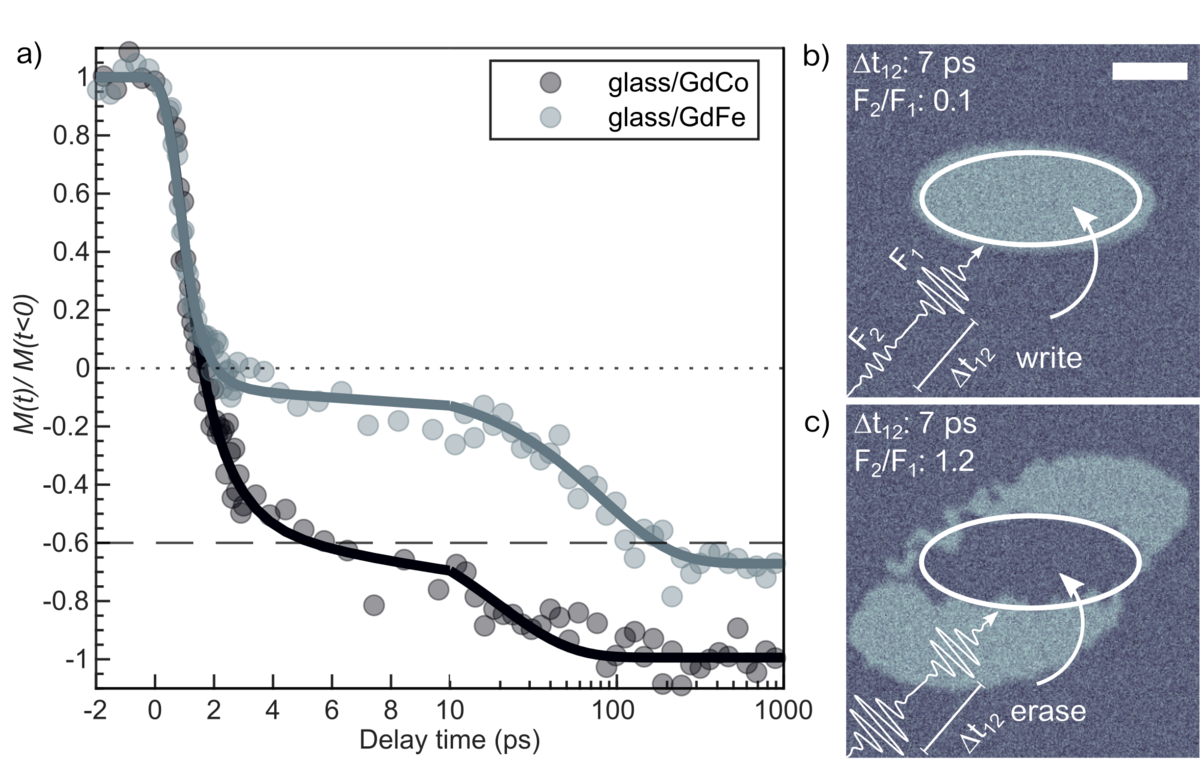Researchers at Max Born Institute and Freie Universität Berlin have now found a way to reduce the fundamentally required time between switching events to a record value of seven picoseconds.
According to an estimate of IBM the current daily production of digital information exceeds 2.5 quintillion bytes (equivalent to about 50 million of dual-layer Blu-ray discs, which stacked on top of each other would be 60 km high) and continues to grow at a staggering rate. The vast majority of this data is stored magnetically, where a binary bit, 0 or 1, corresponds to opposite magnetization directions, and is nowadays typically written or erased by current-driven electromagnets. As this process poses fundamental limitations with regards to speed and energy efficiency, the discovery of all-optical switching (AOS) allowing to set the magnetization direction only using light pulses – and hence to write or erase a magnetic bit – is hailed as an exciting new approach for future data storage technology. AOS has been observed in magnetic materials containing rare-earth elements and transition metals, e.g. in ferrimagnetic GdFe alloy. Here, optical excitation with femtosecond laser pulses leads to a very rapid heating of the electrons to well above the Curie temperature and a corresponding loss of the magnetization within the magnetic material. Exchange of spin angular momentum between the two elements Gd and Fe can then promote reversal of the respective magnetization. Importantly, the temperature of the atomic lattice is only very moderately increased, making AOS intrinsically energy efficient. While this process has been extensively studied, both theoretically and experimentally, only little is known about the maximal frequencies of write/erase cycles using subsequent laser pulses, crucial for the success of AOS in future data devices.
Scientists from the Max Born Institute and the Freie Universität Berlin followed two strategies to minimize the temporal separation of two consecutive femtosecond laser pulses to toggle the out-of-plane direction of the magnetization of such rare-earth transition metal alloys. First, by systematically changing the heat transfer rates using amorphous glass, crystalline silicon or polycrystalline diamond substrates below the alloy, it was demonstrated that efficient cooling rates of the magnetic system present a prerequisite to accelerate the sequence of write/erase cycles. Second and more importantly, replacing the transition metal iron by cobalt lead to a significantly faster recovery of the (switched) magnetization after optical excitation. The comparison of the ultrafast magnetization dynamics of a GdFe and GdCo alloy after single pulse excitation is shown in Fig. 1a). While the initial demagnetization is very similar, the relaxation rate to a reversed magnetic state is vastly different. While GdCo reverses its magnetization to 60% within 5 ps, in GdFe the same value is reached only after approximately 200 ps. The researchers rationalized this observation by the stronger Co-Co vs. Fe-Fe exchange interaction leading to a faster magnetic ordering of the transition metal sublattice. The respective results of the double pulse experiments for GdCo are shown in Fig. 1b and c: magneto-optical images display the opposite magnetization direction of the final state for a pulse-to-pulse separation of only Δt12=7 ps. In b) the fluence of the second pulse, F2, is insufficient to influence the magnetization set by the first pulse. In c) F2 is increased and the magnetization is successfully switched back.
To the best of the team’s knowledge, this presents the fastest sequence of magnetization reversal to date, approaching terahertz repetition rates for write/erase cycles of magnetic bits.


